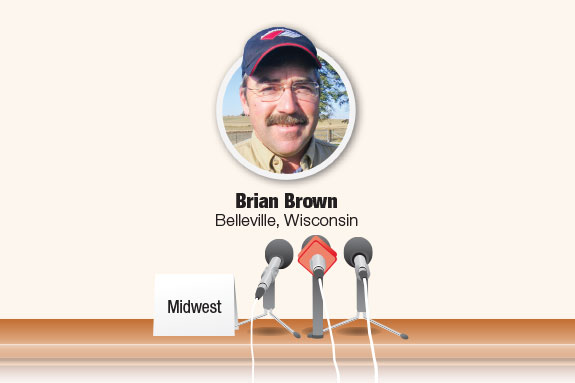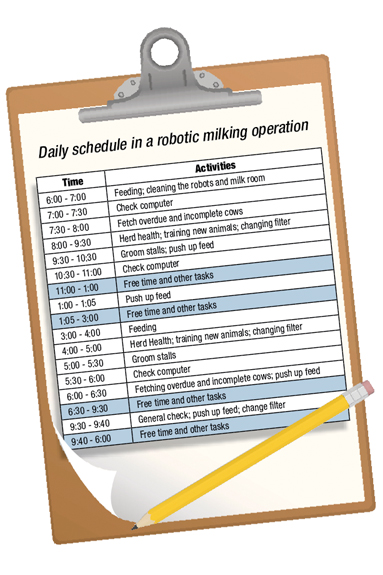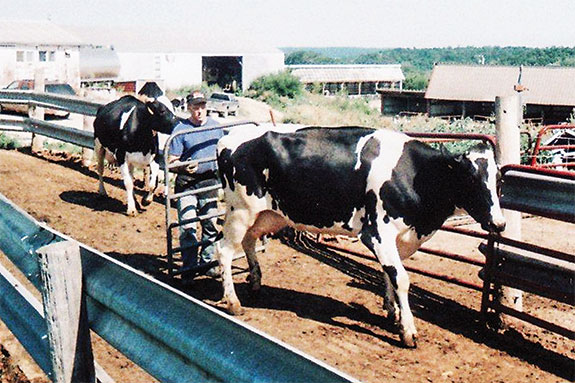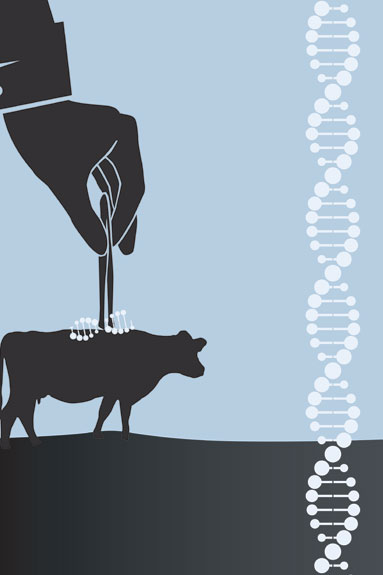We asked our team of editors to select their picks for the best content from Progressive Dairyman over the past year. Of those lists, we compiled a Top 10. Read on for a summary of each article and commentary from an editor. or scroll down for each editor's individual top 10 picks.
1. Milk: The superior product with inferior marketing

Published: March 21, 2013 print issue
From the editor: In this article, David Lightsey, a professor of nutrition at Bakersfield College in Bakersfield, California, describes why he believes the dairy industry has lost market share with athletes to inferior products. The six reasons he lists as the causes of this trend are rooted in misinformation and deceptive marketing.
The author of this article contacted me at this time last year. I agreed with his assessment about the decline in fluid milk consumption in the U.S. today. In pitching his article to me, he wrote, “I feel much of the dairy industry’s drop in milk sales is due to consumer ignorance, as I have seen repeatedly in the classroom and during presentations … Some of the most basic concepts as to why milk is a better choice escapes consumers because of the many myths and misconceptions they embrace.”

I hope dairymen read this article to see just one example of how milk marketing is underserving an audience that should be easy to capture. We must acknowledge that fluid milk consumption decline is not just about consumer preferences or demographics. Other factors are contributing to this trend.
The industry should address those rooted in misconception and stand up to marketing bullies who deceive consumers with copycat products. Surrendering this historically strong category of dairy demand would be a tragedy.
— Progressive Dairyman Managing Editor Walt Cooley
2. Producer panel: Herd health and hoof protocols

Published: March 1, 2013 print issue
From the editor: This article was the final in a series of roundtable discussions that featured Brian Brown from Wisconsin, Greg Hooker from California, and the Risser family from Pennsylvania discussing protocols and lessons learned on their operations. It was one of several roundtable-format articles featured in the magazine over the past year.
On-going research supports that reducing stocking density in fresh cow pens is paramount in transitioning healthy cows through this critical period.
These dairies aim for 80 percent, and Hooker has strived to cut down to 75 percent. The difference was noticeable and immediate, he noted. On the hoof care side, each of the dairies keeps an open line of communication with their hoof trimmer, who is considered to be a valuable member on each of their teams.

While fresh cow and hoof care protocols certainly impact production, reproduction and the overall bottom line on a dairy, there is a bigger picture here. Our ability to transition cows is part of promoting longevity of the animal and sustainability within the herd.
In a similar way, a proactive approach to addressing lameness supports animal well-being. These two key areas are part of good animal health and welfare, and while we have come a long way in understanding and improving them, there is still work to be done at the farm level.
— Progressive Dairyman Editor Peggy Coffeen
3. A day in the life of a robotic milking producer

Published: May 21, 2013 print issue
From the editor: Working smarter rather than harder is the message Francisco Rodriguez, dairy management adviser for DeLaval, pointed out in this article. He broke down the daily and weekly routines dairymen can expect when operating a robotic milking system.
Even though robotic milking technology has been in the U.S. for 13 years, its more recent expansion in the industry has driven the need for more information.
Francisco Rodriguez has written several articles relating to robotic milking systems this past year. This one, in particular, stood out to me because it shows that robots don’t necessarily lighten the workload, contrary to what some might believe or expect.
— Progressive Dairyman Editor Karen Lee
4. Cow psychology: Handle them by getting into their heads
Published: March 1, 2013 print issue

From the editor: “Cows are herd animals, and they also exist within a dominant-submissive hierarchy,” writes Edwin ‘Skip’ Blake in this article about cow psychology. “Everyone gets the herd part, but sometimes we forget the dominant-submissive part.”
The author, a hoof trimmer by trade, gives tips on how to handle dominant cows.
This article was published before I came on board at Progressive Dairyman , and so I did not read it until I scoured through back issues of the magazine. The clever headline was the first thing to catch my attention.
How do you get into a cow’s head? There are several ways, Blake writes, and then he gives some good examples – such as using the boss cow last in a herd hoof-trimming session. Otherwise, if you use the dominant cow first, she might “turn around and harass other animals we are still working with.”

Blake gives other suggestions, of course, and he stresses the importance of treating animals with kindness and patience while still getting Bossy Bessie to behave.
Get into their heads, and they’ll get into the pens – or wherever else you want them. If you haven’t yet tried Blake’s suggestions, you might consider doing so the next time you’re working with your herd.
— Progressive Dairyman Editor Andy Weeks
5. What’s the real story behind aspartame in milk and Lack of knowledge on labeling fuels aspartame fires
Published: June 11, 2013 and July 1, 2013 print issues
From the editor: This two-part article by freelancer Dave Wilkins discussed why non-nutritive sweeteners, such as aspartame, were in the news this year. These sweeteners are widely used in adult beverages (Think of your favorite “diet” soft drink). The dairy industry – both co-ops and processors – had petitioned the FDA to use these sweeteners in milk for kids without having to designate it in any special way (i.e., “reduced calorie” or “no sugar added”) on the front label. The articles explained why the petition had some watchdog groups up in arms.
These articles again spoke to the challenges of reversing the fluid milk consumption trend. I’ve had calls from dairymen this year, as I get in most years, complaining kids aren’t learning to drink milk in schools. Most of the school offerings, they say, are “plain milk,” unflavored low-fat or skim milk.

Granted, low-fat chocolate milk is available. But the regulations about how much “nutritive” sugar sweeteners can be added are under careful watch and seem to be getting stricter.
The reactions of others covered in this article seem to show that one option the industry was pursuing to overcome this challenge of training kids to drink milk is a dead end.
— Progressive Dairyman Managing Editor Walt Cooley
6. What should I do? We never win

Published: May 21, 2013 print issue
From the editor: “What should I do?” is an article in which a real-life farm question is answered by three industry experts. In this piece, Gregorio Billikopf of the University of California, Marko Sosa of Vi-Cor, and Tom Wall of Dairy Interactive, LLC tackle the difficult topic of parlor incentives.
This new column in Progressive Dairyman gives producers an outlet to get their questions answered. Chances are, if one dairy producer is struggling with this situation, there are at least a handful of others in the same boat.

I chose this specific example as a favorite article because when I hear dairy producers respond to the question, “What incentive programs do you use for your parlor team?” the typical answer is: “We’ve tried a number of them.”
I believe this article provides a basis for all those struggling to find the right way to motivate their employees.
— Progressive Dairyman Editor Karen Lee
7. What makes precision dairy technology worth the expense?
Published: September 21, 2013 print issue
Summary: Automated milking systems, mastitis detection and estrus detection monitors are among the growing categories of precision technologies available to dairy producers. Such advancements come with a price tag, and according to Dr. Henk Hogeveen, there are a few key factors that dictate the successful implementation of a precision dairy system.
From the editor: As the article points out, a precision system is worth the investment when it can collect clear, useful data and interpret it in a take-action format, present a cost-savings over time or address a problem such as labor availability.
From conversations I have had with dairy producers and dairy technology providers, there are a few more key success factors to add to the list. First, the dairy must have a manager or family member who is tech-savvy and willing to learn. Automated milking systems, for example, open up a wealth of information never before available cowside. Utilizing this data to its full potential requires having the right person monitoring it and acting upon it. Second, producers must understand that this is not plug-and-play-and-walk-away technology.

While flexibility is something users come to enjoy, there is still a fair amount of work to be done, particularly in the form of management. And last, precision dairy technology is not a solution for poor management. Even with new technology, the same core principles of good cow-sense still apply.
— Progressive Dairyman Editor Peggy Coffeen
8. All bottled up in Tennessee
Published: November 1, 2012 print issue
From the editor: This article profiles Earl and Cheri Cruze of Knoxville, Tennessee, who started bottling their own milk in 1981. Despite setbacks and naysayers, they’ve been able to establish a name for themselves, staying small but remaining profitable some 30 years later.
I like this article by my colleague Fredric Ridenour a lot because it shows the determination of a Tennessee family who, despite the pessimism from others, found success in a dream to bottle their own milk. “Everybody kept telling me I was crazy,” Edwin Cruze is quoted in the article. “Even the (dairy) inspector said I’d be better off selling my milk to the other fella.”

That didn’t stop Cruze and his wife, Cheri, from plowing ahead to make their dream come true. It didn’t come easy, but it came, and the dividends have been noticed through the years.
Now they’re making ice cream and have received suggestions to franchise. “But that’s not really the fun,” Cheri said. Their inspirational story is a lesson for all dairymen and others who’ve ever had a dream.
— Progressive Dairyman Editor Andy Weeks

Published: September 21, 2013 print issue
From the editor: This article by Matt Lucy from the University of Missouri explains how research for the human genome transcended to the dairy industry and allowed for individual alleles to be identified.
It further considers whether the best dairy cow will be defined by breed or by her DNA sequence.
As I listened to Matt Lucy talk about the future of dairy reproduction at the Western Canadian Dairy Seminars in Red Deer, Alberta, he mentioned the possibility of building a super-cow.
Given that farmers are known for their loyalties to brand and breed – red versus green, Ford versus Chevy, Holstein versus Jersey, the idea of creating a “mutt” with superior dairy genetics sounded quite interesting.

When I invited him to expand on his thought of cherry-picking alleles, I was surprised to see how quickly the field of genetics is advancing.
Whether or not you are embracing the world of genomics, I believe we must come to terms with the fact that it is now entrenched in the dairy industry and will have a faster impact on how cows will look and perform now than what breeding programs have accomplished in the past.
—Progressive Dairyman Editor Karen Lee
10. News commentary: Hidden-camera activist reveals himself

Published: September 1, 2013 print issue
From the editor: This article offers insight into an activist’s stint on an Idaho dairy, where he was hired as a worker and used a hidden camera to video animal abuse at the hands of fellow farm workers. He makes his mission and that of his affiliated group, Mercy for Animals, quite clear: to stop people from eating animals.
It seems that videos like these pop up all too often through our social media outlets, which also serve as a news source for many of us. But when they do, my Facebook feed is populated almost immediately with heartfelt, compassionate comments from the people who provide animals with care every single day.
They cherish their role as caretaker and nurturer of the animals that provide their livelihood, and they strongly detest the blanketed title of “abuser” that is conveyed by activist groups. It simply goes to show that our story, in our words and from our own mouths, cannot be told enough. We should commend the dairy producers and industry supporters who refuse to be falsely labeled and choose to make their own headlines when news like this breaks.

Such events must also prompt us to take an introspective look at the not-so-pretty activities that happen on our dairies. How are we handling those situations? As defined in the famous quote from C.S. Lewis, “Integrity is doing the right thing, even when no one is watching.” If the world could see what we or our employees are doing, would we still do it?
— Progressive Dairyman Editor Peggy Coffeen
Editors' picks: Individual lists
Select a link below to see that editor's top selections of 2013 articles.
•
•
•
•

Peggy Coffeen
1. What makes precision dairy technology worth the expense?
2. News Commentary: Hidden camera activist reveals himself
3. Dairy crosses over into beef industry with Limousin genetics
4. Producers share experiences with robotic milking models
5 Dairy switches to new amino acid feeding options
6. Where should you spend? Selecting the best investment
7. Shrink-anomics! What are shrink losses costing your operation?
8. Producers take control of quality with complete dry cow care
9. Cow psychology: Handle them by getting into their heads
10. Progressive panel: Herd health and hoof protocols

Walt Cooley
1. Milk: The superior product with inferior marketing
2. Meeting post-fresh transition cows’ energy, protein challenges
3. Can you break the 30,000-plus-pounds barrier?
4. What does it mean to be an ‘antifragile’ dairy?
5. A look at New Zealand milk prices
6. What’s the real story behind aspartame in milk?
7. Disease surveillance 101: Keeping accurate health records
8. Panel shares how they hurdled under 100,000 SCC
9. Improve employee performance: Consider what drives them
10. Pay to play: Supply management in Montana’s dairy industry
11. Six elements to dairy profitability the top 1 percent use
12. Understanding why cows get sick during the transition period

Karen Lee
1. Multiple issues – Progressive Panel series
2. Meet your dairy consumer – Santa Claus
3. Wisconsin dairy teams up to tackle reproduction
4. Milk: The superior product with inferior marketing
5. Why ultrasonography could help you find what you’re missing
6. What should I do?: We never win
7. A day in the life of a robotic milking producer
8. Developing the next generation: What are we telling our kids?
9. Building the super-cow
10. Father and son dairymen advocate early cancer screening
11. Automatic feeding systems deliver more feedings, less labor

Andy Weeks
1. Gone, but never forgotten: A tribute to Leontien
2. What is precision dairying?
3. For American dairy farmers, later isn't soon enough
4. Focus on the front lines
5. Progressive Forage Editor receives award from AFGC
6. Mentoring dairy veterinarians for a brighter future
7. Close the door on the risks of salmonella this summer
8. All bottled up in Tennessee
9. Cow psychology: Handle them by getting into their heads
10. How's the air down there?



